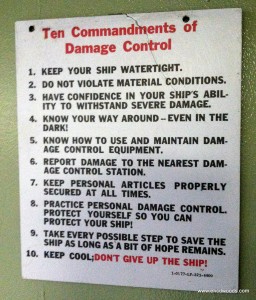 In January, 1954, at 5pm on a Sunday, the USS Midway collided with a smaller vessel, the USS Great Sitkin, while entering port in Athens, Greece. The ships were side-by-side, transferring materials and supplies in rough seas—there were 15-foot swells between the ships. The damage was minimal, however, and repairs to the ship were made while Midway continued her mission.
In January, 1954, at 5pm on a Sunday, the USS Midway collided with a smaller vessel, the USS Great Sitkin, while entering port in Athens, Greece. The ships were side-by-side, transferring materials and supplies in rough seas—there were 15-foot swells between the ships. The damage was minimal, however, and repairs to the ship were made while Midway continued her mission.
Thirty-four such incidents tell part of the story of Midway and her crew during 50 years at sea. On my recent tour of the retired aircraft carrier, I saw this official-looking sign posted in an administration office for the ship’s commanding officer: Ten Commandments of Damage Control.
In a crisis, whether a collision at sea, or a failure in your home or office, these same principles can help you keep your ship afloat. In this three-part series, I’ll make application of these Ten Commandments for life, leadership and ministry.
1. Keep your ship watertight.
Of course, when you’re piloting a billion dollar floating city on the open sea, the last thing you want is to take on water. The Midway, and other ships, are designed to be able to isolate damaged areas, to prevent the infiltration of water beyond the damaged area and into critical systems.
When crisis hits in business or the church, we need to do the same thing: Isolate the problem and prevent it from spreading to other departments, teams and programs. You can keep problems from spreading by identifying them quickly, and addressing them immediately. Even small issues can become a major crisis if left unchecked over long periods of time.
2. Do not violate material conditions.
Aboard a ship, material conditions are the defined parameters for operating under the current circumstances. Each hatch and door is labeled and identified with a set condition (X, Y or Z) under which it is to remain closed. Under normal circumstances, during peace time, many would remain open. But when there is war or threat of war, a different condition exists and some are never to be opened. During a crisis, many more are closed. Attention to these conditions keeps the ship in a state of ready, to withstand further damage if it comes.
Our organizations should have a standard condition for operations too. During normal circumstances, members of our teams may have great freedom and latitude for spending and decision-making. But when troubles hit, conditions may change, and we may need to tighten up reigns, and involve leadership more closely in making key decisions about spending, major changes, and other key business operations.
At home, you may make the same kinds of decisions when troubles or uncertainty loom. Financial guru Dave Ramsey recommends that families facing major illness or even pregnancy, adjust their budgets and savings habits to “pile up money” as a reserve until the uncertainty has passed.
3. Have confidence in your ship’s ability to withstand severe damage.
The USS Midway is a huge ship, built of thousands of tons of steel, and capable of taking on millions of gallons of water while continuing to operate. Panic is never a sailor’s friend, and the ability to trust a well-built, well-designed ship will pay off huge when crisis hits.
An organization with strong leadership, key systems and guiding principles, and a clear mission and vision will also be able to weather such a conflict. Whatever the problem you are facing at home, at work or in ministry, trust your organization. It can handle more than you think, if you just don’t panic.
What is the first thing you do when a crisis hits?
My next two posts will address the key role of good information in a crisis, and personal responsibility when crisis hits.